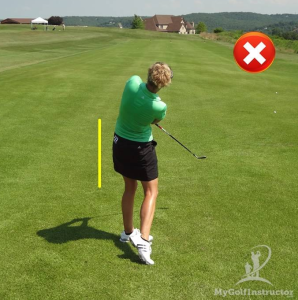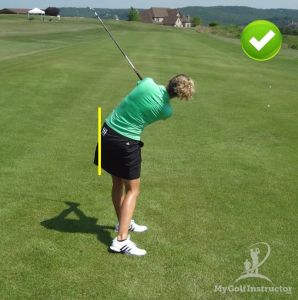 Today Links Life Golf is featuring a guest post from long time LPGA Instructor Maria Palozola. Maria has quite an impressive resume. She has been named a top teacher by both Golf Digest and Golf Magazine. She’s a three time LPGA Midwest Section Teacher of the Year and she ranks in the Top 50 LPGA Instructors.
Today Links Life Golf is featuring a guest post from long time LPGA Instructor Maria Palozola. Maria has quite an impressive resume. She has been named a top teacher by both Golf Digest and Golf Magazine. She’s a three time LPGA Midwest Section Teacher of the Year and she ranks in the Top 50 LPGA Instructors.
Click here for her full bio and visit her websites at the end of this page. And read on, this is good stuff.
Posture is your swing’s foundation. It is the very blueprint around which your swing is constructed. The major components of your swing, from swing plane, to pivot, to weight shift, react to the posture you establish at address. Both how far the ball goes and where it goes can be determined by how you set up at in your starting position.
Posture is by far one of the most often overlooked aspects of the golf swing. It is a rare occasion and I mean rare, when someone comes to the lesson tee with perfect posture. Not many take the time to understand what good posture looks like, nor do they take the time to try to change how they are setting up for the better. I believe this is because they are both so consumed by making “the perfect swing” and also unaware of the dramatic affect that their starting position is having on their ball flight.
In times past you did see some slop when it came to posture on the tour, but with today’s young players from Tiger Woods to Rory McIlroy to Adam Scott you will see balance, good alignment and in most cases a perfectly straight spine. If everyday players made the adjustments necessary both physically (in the gym) and in their set up they would not need to make so many impossible to repeat compensations in their swing. Establishing the perfect posture is not where it stops though. You need to also maintain it throughout the entire swing and this is where most people struggle. If I had to put a number on it I would say more than 90% of  golfers that come across my lesson tee come out of their posture during the swing. The list of swing errors that result from topping to blocking is a long one.
golfers that come across my lesson tee come out of their posture during the swing. The list of swing errors that result from topping to blocking is a long one.
Where Do You Start?
The first step is understanding how to get yourself into a solid starting position. To help, there are 2 things I want you to make note of:
1) You need to have a straight spine.
2) You need to bend from the hips, not the waist.
When golfers bend from their knees first or too much, they will then slump forward from the waist rounding their spine. This brings the shoulders forward, limits the ability to turn and makes it very difficult to keep the club on plane. I give my students the acronym BFD. This stands for bend from the hips, flex from the knees and drop the arms. If you place a club across your hips, keep your shoulders back and chest out and bow over it, you will get the correct feel of bending from the hips, not the waist.
If you have difficulty keeping your spine straight, try this drill:
Place your club behind your back keeping one end attached to the back of your head and the other end attached to your tailbone. Bow forward until you can comfortably see the ball keeping both ends attached to your spine. Then add some knee flex (just a bit) and bring one arm around in front of you at a time letting them hang from your shoulders. Where they fall is where you should be gripping the club.
Now Your There, But How Do You Stay Put?
One of the most common swing faults in golf is what we call “early extension” or a “pelvic push”. This is when a golfer, whether or not they started in good posture, changes their posture and stands up through the swing. Their rear end moves in towards the ball, their spine strightens up and this pushes the arms and hands forward away from their body. As a result, the club shaft angle steepens and they come back to the ball with something quite different than what they started with. Tops, shanks and pushes are just a few among a number of poor shots that result from this swing flaw.
To correct this, I use one of my favorite drills called “Butt Back Drill”.
Butt Back Drill – For this drill you can use a physio ball and put it between your rear end and the wall. A ball is best because it will give you instant feedback by dropping to the ground if you stand up. If you don’t have one available simply putting your rear end against the wall or against a gate between hitting stalls will work well enough to give you good feedback. When you swing the club back make sure that the right side (for right handed players) of your rear end is pushing into the ball. When you swing down, make sure the left side (or front side) of your rear end pushes into the ball and remains connected until your finish.
Quite often postural issues in the golf swing are purely physical. To help correct your posture make sure your hamstrings, calves, quadriceps, abdominals and glutes are both mobile and strong. Lack of mobility and weakness in these muscles can cause you to become unstable.
Remember posture is the the blueprint around which your foundation of a solid swing is built. Too often students end up coming for more and more lessons simply because they have gotten off kilter with their posture, were lazy about correcting it and as a result developed compensations in the swing.
If you don’t pay attention to detail and don’t constantly monitor how you are setting up, your swing can come crumbling down.
Maria Palozola has been teaching for over 20 years with the LPGA and is considered one of their Top 50 Instructors. She was voted the LPGA Midwest Section Teacher of the Year in 2013, 2011 and 2008. Golf Digest ranks her as a Top 5 Teacher in the State. She instructs online at her game improvement site mygolfinstructor.com and in person at stlouisgolflessons.com
